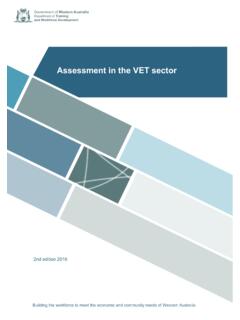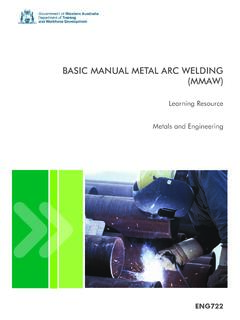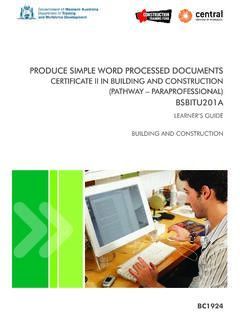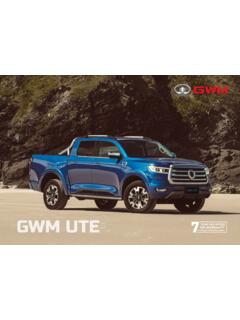Transcription of Modify or Repair Chassis/Frame and Associated Components
1 Modify or Repair Chassis/Frame and Associated Components Workbook(AUM8101A)AUT035 AUM8101 AModify or Repair Chassis/Frame and Associated ComponentsWorkbookCopyright and Terms of Use Department of Training and Workforce Development 2016 (unless indicated otherwise, for example Excluded Material ). The copyright material published in this product is subject to the Copyright Act 1968 (Cth), and is owned by the Department of Training and Workforce Development or, where indicated, by a party other than the Department of Training and Workforce Development. The Department of Training and Workforce Development supports and encourages use of its material for all legitimate purposes. Copyright material available on this website is licensed under a Creative Commons Attribution (CC BY ) license unless indicated otherwise (Excluded Material).
2 Except in relation to Excluded Material this license allows you to: Share copy and redistribute the material in any medium or format Adapt remix, transform, and build upon the material for any purpose, even commercially provided you attribute the Department of Training and Workforce Development as the source of the copyright material. The Department of Training and Workforce Development requests attribution as: Department of Training and Workforce Development (year of publication). Excluded Material not available under a Creative Commons license: 1. The Department of Training and Workforce Development logo, other logos and trademark protected material; and 2. Material owned by third parties that has been reproduced with permission.
3 Permission will need to be obtained from third parties to re-use their material. Excluded Material may not be licensed under a CC BY license and can only be used in accordance with the specific terms of use attached to that material or where permitted by the Copyright Act 1968 (Cth). If you want to use such material in a manner that is not covered by those specific terms of use, you must request permission from the copyright owner of the material. If you have any questions regarding use of material available in this product, please contact the Department of Training and Workforce Development. Training Sector Services Telephone: 08 6212 9789 Email: Website: First published 2008 Published by and available fromWestOne Services Prospect Place West Perth WA 6005 Tel: (08) 9229 5200 Fax: (08) 9227 8393 Email: images: 2008 JupiterImages Corporation Department of Education and Training 2008 Not for NEALS Developed by the Curriculum Support Services Network 2008 Content expertise provided by Colin rights reserved.
4 No part of this publication may be reproduced, stored in a retrieval system or transmitted in any form or by any means, electronic, mechanical, photocopying, recording or otherwise, without the prior written permission of the Western Australian Department of Education and every effort has been made to ensure the accuracy of the information contained in this publication, no guarantee can be given that all errors and omissions have been excluded. No responsibility for loss occasioned to any person acting or refraining from action as a result of the material in this publication can be accepted by the Western Australian Department of Education and 978-0-7307-9922-1 AUM8101A Modify or Repair Chassis/Frame and Associated .
5 1 Repairing and modifying chassis .. 1 chassis .1 Monocoque .. 1 Space frame .. 2 Ladder 2 chassis rails .. 2 Single skin .. 4 Double 4 Reason for chassis modifications ..6 Inspection of the chassis Measuring chassis frame .. 6 Laser measuring .. 6 String .. 7 Drop line test .. 8 Paperwork Inspection report .. 10 Job or rectification of chassis Components ..14 Drilling and bolting of attachments .. 15 Alignment and modification of chassis frame ..19 General requirements .. 19 Wheelbase alteration .. 19 Rear overhang.
6 19 Suspension relocation .. 20 Cutting the chassis ..24 The most common methods of cutting a chassis .. 24 Double skinned chassis .. 25 Contracting (shortening) the chassis .. 27 Welding of the chassis .. 29 Frame rail reinforcement ..31 Australian Design Rules ..33iiAUM8101A Modify or Repair Chassis/Frame and Associated ComponentsTurning circle ..36 Drive shaft alterations ..38 Critical speed and length of tail shaft .. 39 General 39 Universal joint angle .. 40 Operating angle calculations for tail shafts .. 40 Two joint tail 41 Parallel joint tail shaft .. 41 Nonparallel joint tail shaft .. 42 Three joint shaft .. 42 Height of new centre bearing .. 43 Universal joints.
7 49 49 Length of slip joints ..52 General design and installation guidelines .. 52 Suggested practical exercises ..55 AUM8101 AModify or Repair Chassis/Frame and Associated Components1 IntroductionRepairing and modifying chassisThe chassis frame forms the backbone of a heavy vehicle so the chassis must be able to safely carry the maximum load for which the vehicle is designed. The chassis must also absorb engine and drive-line torque, endure shock loading and accommodate twisting caused by uneven road surfaces. Satisfactory performance of a heavy vehicle chassis is the result of careful design and rigorous testing. Consequently, no modification to a chassis frame should be made before consultation with the vehicle manufacturer or an engineer experienced in commercial vehicle chassis modifications.
8 This will ensure that any proposed chassis modification will not reduce the vehicle s safety or chassis manufacturers have their own design concepts and varying ways of achieving satisfactory overall chassis performance, so not all chassis are the same and chassis Components are not normally interchangeable between different makes and models of vehicles. chassis frames are designed to offer good support for the body and payload and at the same time provide torsional flexibility, mainly in the region between the gearbox cross member and the cross member ahead of the rear suspension. Allowing for chassis flexing is necessary because a rigid frame is more likely to fail than a flexible one that can twist and bend in arduous conditions.
9 A torsionally flexible frame also has the advantage of decreasing the suspension loading when the vehicle is on uneven surfaces, as all wheels can make contact with the road thus sharing the payload over all of the typesMonocoqueMonocoque bodies do not have a separate chassis but instead rely on their one-piece body and chassis construction to gain rigidity. Monocoque vehicles are usually found on smaller vehicles such as a small van, where weight is saved by not having a separate chassis ; the chassis and body are combined to make up one unit, with the body sharing the load stresses. Monocoque is a French word meaning single shell or unibody and is a construction technique that uses the external skin of the body to support some or most of the load on the vehicle.
10 2 AUM8101A Modify or Repair Chassis/Frame and Associated ComponentsSpace frameAnother type of chassis is the space chassis . These chassis are light-weight and usually made of braced tube or RHS. Suburban omnibuses commonly use a space chassis because they are light and flexible and the body adds to the vehicle s typeThe most common type of chassis consists of two chassis rails which run the full length of the vehicle. The chassis rails are made of high tensile pressed steel channels. In a ladder type of chassis , the chassis rails carry all the main Components of the vehicle, such as the engine, gearbox, front and rear axle suspensions. Also adding to the burden of the chassis are Components such as fuel tanks and air style of chassis is called a ladder chassis because, when laid out with cross members, they roughly represent a ladder railsChassis rails are made of high tensile steel usually in the order of about 440 Mpa and upwards with a yield strength of 760 Mpa, compared with mild steel, which has a tensile strength of around 410 chassis rail is made up of two flanges and a web.










